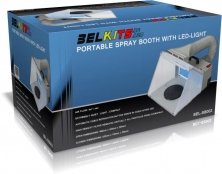
1/35 British Army Ah Mk 1 Apache Longbow Attack Helicopter
- Etat du stock:Disponible en 2-4 semaines
- Code produit:TAK02604
- Marque:Takom
Description
Takom - 1/35 British Army Ah Mk 1 Apache Longbow Attack Helicopter
Sixty-seven multi-mission helicopter gunships were ordered for the British Army Air Corps (AAC) in 1995. Based on the American Boeing AH-64D Apache Longbow twin-engine tandem-seat helicopter, the first eight were built by Boeing in the United States from 1998 to 2000 to a Uk design developed by Westland Helicopters (now AgustaWestland). The remaining 59 were assembled in the Uk by Westland between 2000 and 2004.
The Westland 'WAH-64' specification incorporated several unique enhancements compared to the US AH-64D, including British avionics, revised weapons load, more powerful engines supplied by Rolls-Royce-Turbomeca, and folding rotor blades for transportation, stowage and shipboard capability. The Ministry of Defence designation is Apache Ah Mk 1, serial nos ZJ166'ZJ200/ZJ202'ZJ233.
In 2000-2003 651 Squadron Army Air Corps, Army Aviation Centre (AAC), Middle Wallop, served as the Attack Helicopter Fielding Squadron to commission the Westland Apache Ah Mk 1 for service. Army Air Corps Apaches are operated by Squadrons 653, 662 & 663 of 3 Regiment (3 Regt AAC) and Squadrons 656 & 664 of 4 Regiment (4 Regt AAC), based at Wattisham Flying Station, Suffolk. Type training is undertaken by 7 (Training) Regiment Army Air Corps, 673 Squadron AAC, Middle Wallop.
In 2004/05 the Royal Navy's then current helicopter carrier and assault ship Hms Ocean (LPH, Landing Platform Helicopter, L12) was equipped with the infrastructure required to operate Apache helicopters.
Apache AH1 attack helicopters were first deployed in 2006, to Afghanistan, stationed at Camp Bastion British Army base in Kandahar province. Operation Herrick provided support to ground forces, tactical strikes, reconnaissance and armed escort to other helicopters. Apache helicopters flew more than 50,000 operational hours in Afghanistan from 2006 until withdrawal in 2014.
In 2011 Nato member countries intervened in Libya to prevent Colonel Gaddafi's government forces carrying out air attacks against opposition supporters and the civilian population. Operation Ellamy saw the first mobilisation of Apache helicopters from the sea, flying from helicopter carrier Hms Ocean. Attack helicopters from 656 Squadron Army Air Corps were able to target pro-Gaddafi forces with a high degree of precision, and played a major role in protecting Libyan civilians from the Gaddafi regime.
Apache AH1 manoeuvres have been trialled on board the Royal Navy's newest aircraft carriers Hms Queen Elizabeth R08 in June 2019 and Hms Prince of Wales R09 in June 2019.
The Army's Attack Helicopter Display Team (AHDT) based at Wattisham present exciting demonstrations at airshows around the UK. Markings worn by two Ahdt Apache helicopters in 2015 are included in the Takom kit.
New tooled parts comprise:
- Hidas (Helicopter Integrated Defensive Aids System),
- Rcefs tanks (Reduced Size Crashworthy External Fuel System),
- CRV7 rockets (Bristol Aerospace Canadian Rocket Vehicle 7),
- RTM322 turboshaft engine (Rolls-Royce Turbomeca 322).
Choice of 3 markings:
1) ZJ184, 'Gunship 1', Attack Helicopter Display Team (AHDT), Duxford, Cosford, Fairford, May/June/July 2015,
2) ZJ204, 'Dickson Pioneer III' (after pioneer aviator Capt Bertram Dickson 1873-1913, the first military pilot), Wattisham Flying Station, Suffolk,
3) ZJ205, 'Gunship 2', Attack Helicopter Display Team (AHDT), Duxford, Cosford, Fairford, May/June/July 2015.
Également acheté
Les clients qui ont acheté ce produit ont aussi acheté.




